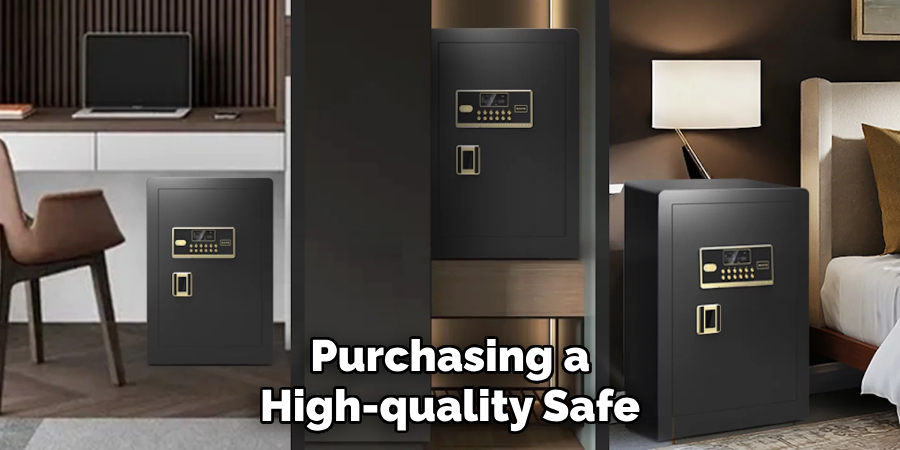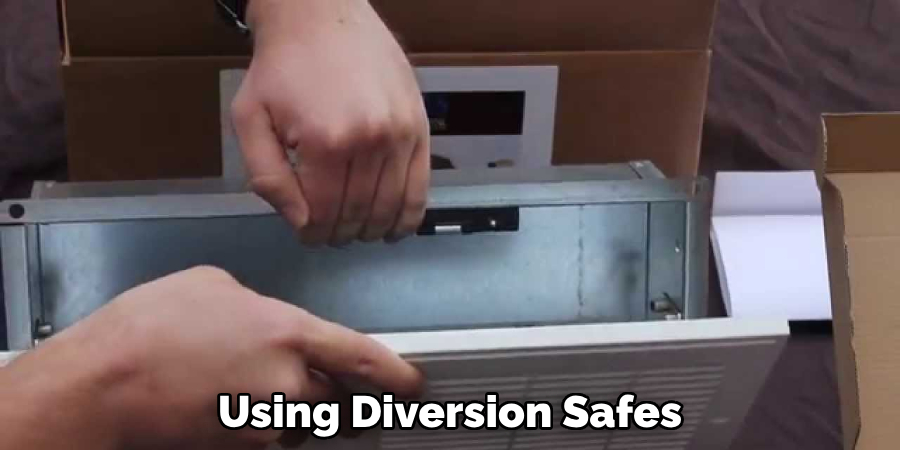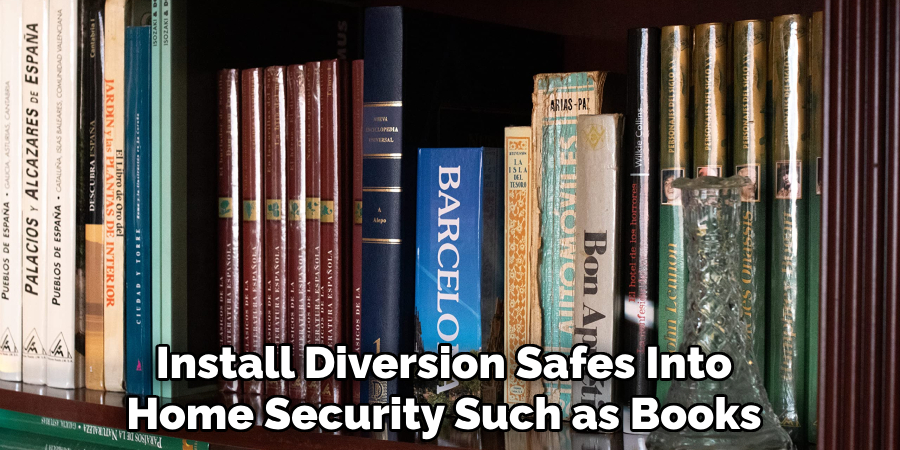In today’s uncertain world, the security of one’s valuable assets, especially gold, cannot be overstated. The need to secure and conceal gold at home arises from the imperative to protect these precious investments from potential theft or unauthorized access. Gold, by its very nature, attracts attention and, if not stored properly, can become an easy target for burglars.

This introduces the critical importance of discreet storage methods. Owners can significantly mitigate the risk of loss by employing methods that ensure the safety and security of such assets. Within this context, our guide offers a comprehensive approach on how to hide gold at home.
It is designed to equip you with the necessary knowledge and techniques to effectively and safely conceal your gold, providing peace of mind through enhanced security measures. Through strategic concealment and the implementation of robust storage solutions, this guide aims to safeguard your valuable gold assets from any potential threats.
Assessing Storage Options
When contemplating how to hide gold at home, the initial step involves carefully evaluating potential storage locations that blend security with subtleness. Here’s a deeper look into assessing these pivotal aspects:
A. Identifying Secure Locations
Selecting secure locations in your home for gold storage cannot be arbitrary. Ideal spots can range from safes bolted to the floor to vaults built into the home’s foundation or even cleverly concealed compartments nearly invisible to the unknowing eye. The goal is to choose places that are hard to find and difficult to access without authorization.

Think of areas that are less likely to be targeted or searched by intruders, such as behind false walls, beneath floorboards, or within custom-built furniture. The effectiveness of these locations hinges on their ability to remain undetected and impenetrable.
B. Considering Accessibility
While security is paramount, accessibility should not be overlooked. In the event of an emergency or when regular access is required, retrieving your gold should not be a Herculean task that compromises its safety. Therefore, the balance between security and accessibility is critical.
For instance, a safe with a digital or biometric lock offers both high security and easy access to authorized individuals. Conversely, highly concealed storage might offer supreme security but can prove impractical for frequent access.
C. Ensuring Privacy
The chosen storage locations must offer privacy and be discreet enough to avoid drawing attention. This requires a thoughtful consideration of how visitors, servicers, or even intruders perceive the interior layout of your home. Avoid common areas or predictable spots like the master bedroom closet or home office, as these are typically the first places an intruder might search.
Instead, opt for areas less associated with valuables. Privacy also entails ensuring that the chosen method of concealment blends seamlessly with your home’s decor, making it virtually invisible to anyone but the homeowner.
How to Hide Gold at Home: Investing in Secure Storage Solutions
Investing in secure storage solutions is crucial when protecting your gold assets at home. These solutions deter theft and provide peace of mind, knowing your valuables are safeguarded with advanced security measures. Here’s a closer look at the options:
A. Purchasing a Safe

For individuals serious about securing their gold, purchasing a high-quality safe or security box designed specifically for valuables is wise. Modern safes offer various locking mechanisms, including combination locks, keypads, and biometric access, which uses fingerprints or facial recognition for entry.
This ensures that only authorized individuals can access the contents. Additionally, safes can be anchored to the floor or wall, making it significantly harder for burglars to remove and open them elsewhere.
B. Installing a Home Vault
Installing a home vault or strongroom is the ultimate security measure for maximum protection. Home vaults are equipped with reinforced walls, doors, and locking mechanisms that are nearly impenetrable.

Designed to withstand attempts at forced entry, drilling, and even fire or flood, these vaults offer unparalleled security. While installing a home vault is more costly and complex than purchasing a safe, it is ideal for storing larger collections of gold or other high-value assets.
C. Concealing Compartment Installation
Concealing compartments or secret storage areas within furniture, walls, or floors provides an additional layer of covert security. These hidden compartments can be custom-built to fit any space, making them a discreet option for storing gold.
Whether behind a movable panel in a bookshelf, underneath a floorboard or integrated within a piece of furniture, these compartments ensure that valuables remain unseen by guests or potential intruders. The key advantage of concealed compartments is their ability to blend seamlessly with the surrounding environment, offering security without attracting attention.
Investing in secure storage solutions for gold protects your valuables from theft and contributes to your home’s overall security. Whether opting for a safe, installing a fortified home vault, or integrating concealed compartments, the priority should be on choosing solutions that effectively balance security, accessibility, and discretion.
How to Hide Gold at Home: Utilizing Diversion Safes
Diversion safes are a cunning blend of concealment and accessibility designed to mimic ordinary household items. They provide an ingenious way to protect small valuables, including gold, within plain sight while effectively camouflaging them from potential intruders.
A. Understanding Diversion Safes:

Diversion safes are ingeniously crafted containers that replicate the look and feel of common household items such as books, cans, or various household products. The key concept behind these safes is deception; they are intended to be so inconspicuous that a thief, in the midst of a hurried search for valuables, would overlook them as everyday clutter.
These safes can house a small amount of gold or other precious items, providing an additional layer of security by virtue of their nondescript appearance.
B. Choosing Suitable Disguises:
The effectiveness of a diversion safe greatly depends on its ability to blend into its surroundings. When selecting a diversion safe, it is crucial to consider the overall decor and common items within your home.
A diversion safe disguised as a book would be apt for a shelf in a study, whereas a can-shaped safe might blend seamlessly into a pantry. The goal is to choose a disguise that appears so ordinary and unremarkable that it never draws a second glance, thereby reducing the likelihood of it being detected by thieves.
C. Proper Placement:
The strategic placement of diversion safes within your home is pivotal in maximizing their effectiveness. The ideal locations for these safes are among genuine items of the same kind. For instance, a diversion safe designed as a dictionary will be most inconspicuous on a bookshelf surrounded by other books.
Similarly, a cleaning product diversion safe would not seem out of place in a utility closet or under a kitchen sink. The key is consistency in context; the diversion safe should appear to belong to its surroundings effortlessly. This strategic placement, coupled with the safes’ innate disguise, significantly enhances the security of the hidden valuables, making them virtually invisible to intruders.

Incorporating diversion safes into your home security strategy adds a layer of subtlety and sophistication, complementing more overt security measures like safes and vaults. By understanding the nature of diversion safes, choosing disguises wisely, and placing them strategically, you can create an effective deterrent against theft, safeguarding your precious gold and valuables with added discretion.
Implementing DIY Concealment Methods
Implementing DIY concealment methods can be a cost-effective and highly personalized way to add another layer of security for your gold and valuables. These tactics involve creativity and the ability to use everyday items and spaces in your home for concealment, providing both secrecy and ease of access. Here’s how you can begin:
A. Creating Hidden Compartments:
Crafting DIY hidden compartments within your home can be an ingenious way to hide your valuables in plain sight. Furniture, walls, or everyday objects can be modified to include concealed hinges, magnets, or false panels that lead to secret storage spaces.
For instance, a floating shelf can be designed to pull forward, revealing space behind it. Similarly, a mirror mounted on a wall can swing open to disclose a hidden compartment. These creative solutions require some handyman skills but are exceptionally effective in keeping your treasures hidden.
B. Utilizing Household Items:
Repurposing everyday household items provides a simple yet clever approach to concealing small gold items. Hollowed-out books, wall clocks, or fake plants can serve as perfect hideaways for your valuables.
This method capitalizes on the intrinsic nature of these items to blend into their surroundings without arousing suspicion. By carefully selecting which items to modify based on how commonly they’re found in your home, you can create effective diversionary safes that pass unnoticed by intruders.
C. Customizing Concealment Solutions:

The beauty of DIY concealment solutions lies in their ability to be customized according to personal preferences, the unique layout of your home, and specific security requirements. By assessing the potential and limits of your living space, you can identify areas that naturally lend themselves to becoming secret storage spots.
Consider spaces that are underutilized or overlooked, such as the underside of kitchen cabinets, inside of door panels, or even within the false bottoms of drawer units. Customizing these solutions allows you to tailor your concealment methods to your living environment, maximizing both the security and accessibility of your hidden valuables.
Incorporating these DIY concealment methods into your broader home security strategy enhances your ability to discreetly protect your gold and other precious items. Whether crafting hidden compartments, repurposing household items, or customizing unique concealment solutions, the key is balancing inventiveness with practicality.
Practicing Discretion and Secrecy
Implementing physical security measures is just one aspect of protection in the quest to secure valuable assets such as gold. Equally critical is the practice of discretion and secrecy regarding the ownership and storage locations of these assets. Below are essential strategies to enhance the security of your gold and valuables through careful information management.
A. Limiting Disclosure:
The foundational principle of safeguarding your gold involves strictly limiting the number of people aware of its presence and specific storage locations. Every additional person privy to this information exponentially increases the risk of inadvertent or intentional disclosure.
It is advisable to confide only in those who absolutely need to know, such as a spouse or a legal advisor, under circumstances where such knowledge is essential. The primary goal is to minimize the risk of this sensitive information falling into the wrong hands, which could lead to targeting by burglars or swindlers.
B. Avoiding Obvious Display:
The urge to share personal achievements or possessions on social media platforms can be tempting in today’s digital age. However, it is paramount to resist this urge when it comes to valuable assets like gold. Publicly displaying or discussing your ownership of gold can attract unwanted attention from potential thieves.
Even seemingly innocent conversations in public places should be avoided, as you never know who might be listening. The key is to maintain a low profile, ensuring that knowledge of your assets remains as private as possible.
C. Educating Family Members:
Ensuring that every household member understands the importance of secrecy and security measures is vital. It’s not enough for just one person to practice discretion; all members, including children, should be made aware of the risks and educated on the importance of not disclosing information about valuable possessions.
This education can involve discussions about the general principle of privacy, the reasons behind it, and practical tips on how to avoid inadvertently revealing sensitive information. It’s essential to create an atmosphere of trust and understanding, emphasizing that these measures are in place to protect the family’s collective well-being.
By adopting these strategies, individuals can significantly mitigate the risk of owning and storing gold. Practicing discretion and secrecy complements physical security measures and forms a critical component of a comprehensive security strategy.
Regular Security Checks
Ensuring the ongoing security of your gold and other valuables requires diligent maintenance and occasional revisions of your chosen security measures. This segment outlines the essential practices for maintaining a secure environment for your assets.
A. Routine Inspections:
Regularly inspecting your storage locations and concealment methods is crucial to ascertain their integrity and functionality. These inspections should be thorough, aiming to discover any potential signs of tampering, wear, or mechanical failure that could compromise security.
Evaluating the effectiveness of locks, the condition of hidden compartments, and the reliability of electronic surveillance (if utilized) should form part of this routine. Regular checks help identify vulnerabilities before they can be exploited, ensuring that your valuables remain secure.
B. Updating Security Measures:
Security is not a ‘set and forget’ matter. It necessitates periodic updates to remain effective against evolving threats. This could mean upgrading lock systems, incorporating more advanced surveillance technology, or changing the locations of concealed assets to keep potential thieves off balance.

Also, consider the impact of changes in your home environment, such as renovations or the arrival of new household members, which might necessitate alterations in your security arrangements. Staying abreast of new security technologies and methods can further empower homeowners to protect their valuables effectively.
C. Reevaluating Risks:
The landscape of home security is dynamic, influenced by factors such as local crime rates, advancements in burglary techniques, and changes in social behavior. Consequently, a periodic reevaluation of your home security risks is essential. This reevaluation should encompass assessing current security measures in the context of new threats or vulnerabilities.
It may reveal the need for changes in your concealment strategies, whether to bolster defenses against a specific threat type or cover previously overlooked vulnerabilities. Understanding these risks and adapting your strategies accordingly is critical in safeguarding your assets against theft or damage.
Adhering to these practices provides a proactive framework for protecting your gold and valuables. Regular security checks, combined with a willingness to update and adapt security measures, form a robust defense against potential threats, ensuring peace of mind and the safety of your precious items.
Frequently Asked Questions
Q1: How Often Should I Perform Security Checks on My Valuables?
A1: Regular security checks are crucial and should be conducted at least once every three months. However, the frequency may need to increase based on factors like changes in the immediate environment or recent upgrades to your security systems.
Q2: What Should I Do if I Suspect My Security Has Been Compromised?
A2: If you suspect any compromise to the security of your valuables, act immediately by conducting a thorough inspection of your storage areas and reviewing surveillance footage, if available. Consider enhancing your security measures or consulting with a security expert for professional advice.
Q3: Are Digital Safes More Secure than Traditional Lock-And-Key Safes for Storing Gold?
A3: Digital safes offer several advantages, including customizable access codes, audit trails, and resistance to certain types of tampering. However, the choice between digital and traditional safes depends on individual security needs and preferences. It is advisable to evaluate both options in the context of your overall security plan.
Q4: How Can I Discreetly Transport Valuable Items to A New Location?
A4: Transporting valuable items discreetly requires planning. Use inconspicuous packaging and choose a trusted courier with experience in handling valuables. Alternatively, consider professional services that specialize in secure transport for high-value items.
Q5: Is It Necessary to Insure My Gold and Other Precious Items?
A5: Yes, insuring valuable assets such as gold is highly recommended. Insurance provides financial protection against theft, loss, or damage. It’s important to choose a policy that covers the full value of your items and understand the terms and conditions, including any situations that might not be covered.
Conclusion
In this guide, we’ve navigated the intricate nuances of how to hide gold at home securely and discreetly, underscoring the pivotal role of limiting disclosure, avoiding conspicuous display, and fostering a culture of awareness within the family. These essential tips form the bedrock of concealing gold and other valuables in a manner that significantly reduces the risk of theft or unwanted attention.
Equally paramount is the emphasis on choosing the right storage solutions — be it safes, hidden compartments, or secure locations known only to a select few. The practice of discretion cannot be overstated; it’s the silent guardian of your treasures. It ensures that knowledge of your assets remains cloistered, thus enhancing their security.
Armed with these strategies and a keen sense of vigilance, you can instill confidence in your ability to implement effective concealment methods. This fortifies the safety of your valuable assets and grants you peace of mind, knowing your gold is well-protected.

